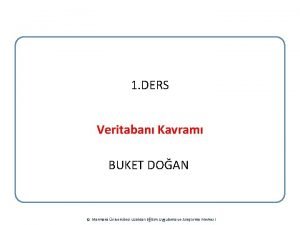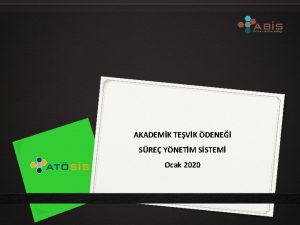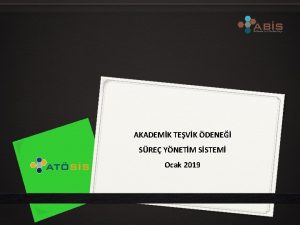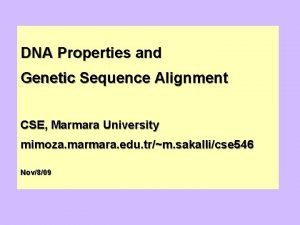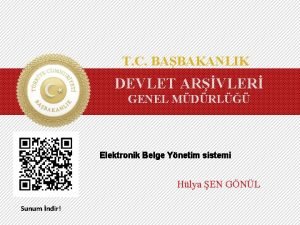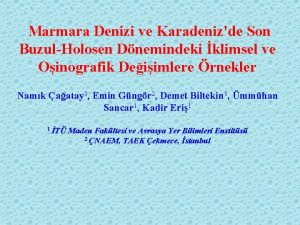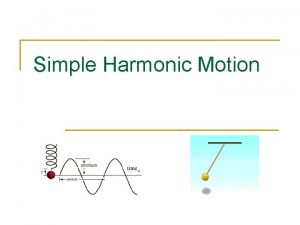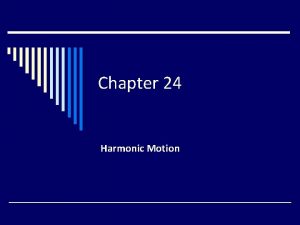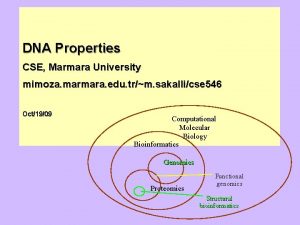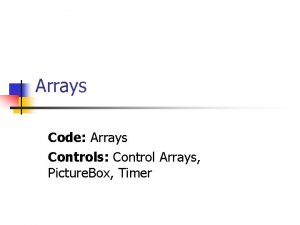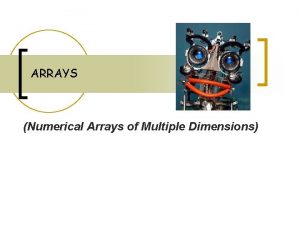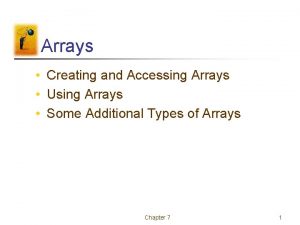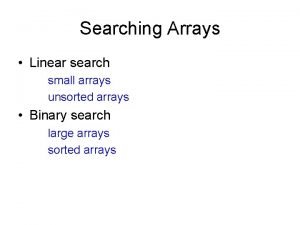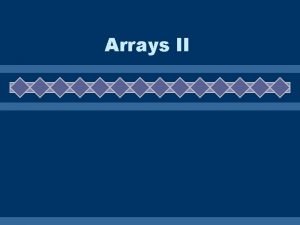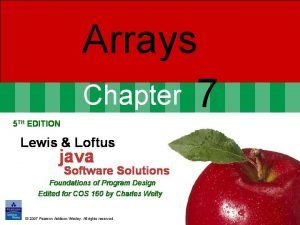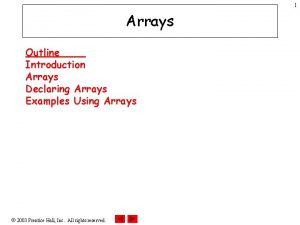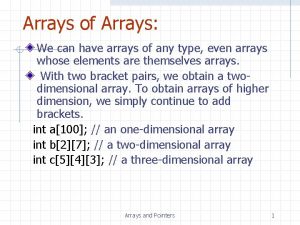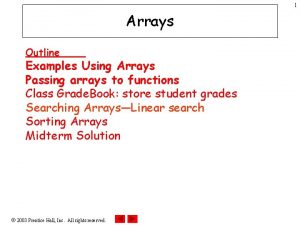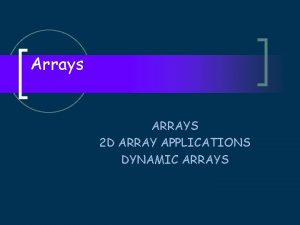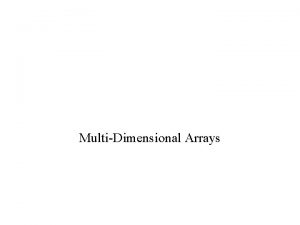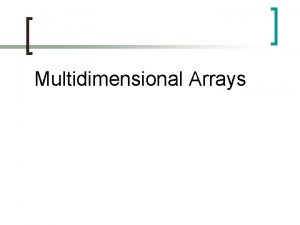Harmonic Control Arrays Murat DORUEL Marmara University Faculty

















![The Behavior for a Constant Reference l 15 <r> = [10; 0; 0]. The The Behavior for a Constant Reference l 15 <r> = [10; 0; 0]. The](https://slidetodoc.com/presentation_image_h/04bbc82ef8f1c2095bf586d89c702646/image-18.jpg)







- Slides: 25

Harmonic Control Arrays Murat DOĞRUEL Marmara University, Faculty of Engineering mdogruel@marmara. edu. tr

Outline l l l “Harmonic Control Arrays” method is introduced. An example is provided to demonstrate how it works. The results and the future work are summarized. 2/24

Motivation l For constant references, the steady state error can be automatically eliminated by simply utilizing an integral term in unitary feedback systems. This is frequently and very usefully employed in many industrial control solutions. r - + e Controller + u Plant y 3/24

Motivation l How can we achieve the zero error performance for systems containing periodic references and/or periodic disturbances? r - + e Controller + u Plant y Signal Producer 4/24

An Illustration of the HCA Idea HCA Dispersed Signal Input Signal Modified Dispersed Signal Output Signal Each harmonic component is individually controlled to construct the output. 5/24

The HCA Method l The method is based on automatically constructing the appropriate control signal by adjusting the complex levels of its harmonic components, using the harmonic components of the reference and output signals. 6/24

Harmonic Control Arrays Block Diagram llhllh r <> <r> HCA <u> >< u Plant y <y> <> 7/24

Harmonic Disperser x <> <x> 8/24

Harmonic Assembler <x> >< x 9/24

Harmonic Control Arrays r <> <r> HCA <u> >< u <y> <> y The HCA block tries to “optimally” construct <u> using <r> and <y> (and their previous values). 10/24

Harmonic PI Control Array r - + e <> <e> + <u> >< u y 11/24

A Sample Application d u + y A typical plant model 12/24

The reference and disturbance signals l l <r> = [2. 7; -1; 0. 5 j; 0. 2; -0. 1 j], <d> = [0. 35; -1. 6+1. 6 j; 0. 25 -0. 3 j; -2. 95+3. 05 j; 2. 5+1. 25 j]. r(t) Reference Input 6 4 2 0 -2 0 1 2 3 4 5 d(t) Disturbance 20 10 0 -10 -20 0 1 2 t (sec) 3 13/24

The system without delay l l l 8 a = 1, Td = 0, KP = diag([2. 5; 10; 15; 20]), KI = diag([0. 9; 4; 10; 10]). The Reference and the Output The Error 6 e(t) 6 4 4 2 2 0 0 -4 0 -2 r(t) y(t) -2 5 10 t (sec) 15 -4 0 5 10 15 t (sec) 14/24

The Dispersion of the Output Signal 4 The Real Parts of <y> 1. 4 The Imaginary Parts of <y> h=0 -> 0 h=1 -> 0 h=2 -> 0. 5 h=3 -> 0 h=4 -> -0. 1 1. 2 3 1 h=0 -> 2. 7 h=1 -> -1 h=2 -> 0 h=3 -> 0. 2 h=4 -> 0 2 1 0. 8 0. 6 0. 4 0 0. 2 0 -1 -0. 2 -2 0 5 t (sec) 10 15 -0. 4 0 5 t (sec) 10 15 15/24

The Composed Control Signal u(t) 60 40 20 0 -20 -40 0 5 t (sec) 10 15 16/24

The System with Delay (Td =0. 1 sec. ) l l 6 KP = diag([1. 1; 0. 4+1. 4 j; 0; -8 -6 j; 1. 5 -4. 7 j]), KI = diag([0. 9; 1. 5+4. 7 j; -10+7 j; -12 -9 j; 5 -14 j]). The Reference and the Output 4 4 2 2 0 -2 0 The Error 6 0 r(t) y(t) 5 10 t (sec) e(t) 15 -2 0 5 10 15 t (sec) 17/24
![The Behavior for a Constant Reference l 15 r 10 0 0 The The Behavior for a Constant Reference l 15 <r> = [10; 0; 0]. The](https://slidetodoc.com/presentation_image_h/04bbc82ef8f1c2095bf586d89c702646/image-18.jpg)
The Behavior for a Constant Reference l 15 <r> = [10; 0; 0]. The Reference and the Output 10 20 5 r(t) y(t) 10 0 -5 0 The Composed Control Signal 30 0 5 10 t (sec) 15 -10 0 5 t (sec) 10 15 18/24

The Robustness of HCA The Error 6 a=1 a = 0. 7 a = 1. 3 4 2 0 -2 0 5 10 15 t (sn. ) 19/24

The Unstable System with Delay l l l a = -1, Td = 0. 1, KP = diag([-1. 65; 3; 0; 0; 10]), KI = diag([-0. 3; 7; 5; 10; 15]). d u + The Reference and the Output The Error 10 10 r(t) y(t) 5 5 0 0 -5 0 5 10 t (sec. ) y 15 -5 0 5 10 15 t (sec. ) 20/24

A Periodic Position Control Example u Data Acq. & Control Host PC Motor Driver M M Load y Position Encoder Linear motion mechanism Total RMS Errors in One Period Method No load Symmetric load Asymmetric load PI 0. 8453 1. 4753 1. 2684 PI+IMC 0. 0716 0. 1327 0. 1037 HCA (H=2) 0. 0658 0. 1139 0. 0863 HCA (H=3) 0. 0528 0. 0867 0. 0696 HCA ( H=4) 0. 0434 0. 0650 0. 0545 21/24

Conclusions - 1 l l The method of “Harmonic Control Arrays ” is introduced. HCA method offers an effective control solution for systems with periodic references and/or disturbances having a certain number of harmonic components. The HCA method achieves the zero error by automatically producing the control signal, composed of the harmonic components at correct magnitudes and phases. This kind of solution is frequently needed and directly applicable for industrial control problems. 22/24

Conclusions - 2 l l l The algorithm can be easily and flexibly implemented on a microcontroller or a digital signal processor as a prototype control solution. Then, the control engineer just need to adjust the PI complex gain matrices for the Harmonic PI Control Array Method. As seen from the examples, despite the delay and disturbance, a fast and robust performance can be achieved. The HCA method allows the famous PID control to be effectively and easily adapted to the systems involving periodic signals. 23/24

Future Work l l l To further develop this method, theoretical investigations about stability and control design should be carried out, and it should be tested on real applications. The other control methods can also be utilized in implementing harmonic control arrays, and HCA can be used in parallel with the other methods. HCA look promising for many industrial applications like control of DC/AC or AC/DC converters as well as noise cancellation type problems. 24/24

Thank You. Any Questions? HCA Dispersed Signal Modified Dispersed Signal Output Signal Input Signal http: //www. rit. edu/~andpph/photofile-c/prism-DSCN 5003. jpg 25/24
 Tension wave
Tension wave Marmara veritabanı
Marmara veritabanı Mimoza marmara
Mimoza marmara Marmara atösis
Marmara atösis Marmara atösis
Marmara atösis Cse marmara
Cse marmara Arsivebys.marmara
Arsivebys.marmara Marmara denizi fay hattı
Marmara denizi fay hattı Körfez marmara hastanesi tahlil sonuçları
Körfez marmara hastanesi tahlil sonuçları University of split faculty of maritime studies
University of split faculty of maritime studies Bridgeport engineering department
Bridgeport engineering department University of bridgeport computer science faculty
University of bridgeport computer science faculty Hubert kairuki memorial university faculty of medicine
Hubert kairuki memorial university faculty of medicine Hyperparathyreosis
Hyperparathyreosis King abdulaziz university faculty of medicine
King abdulaziz university faculty of medicine Florida state university computer science faculty
Florida state university computer science faculty Mendel university faculty of business and economics
Mendel university faculty of business and economics Singularity executive program
Singularity executive program Territorial matrix vs interterritorial matrix
Territorial matrix vs interterritorial matrix Ascaris lumbricoides ova
Ascaris lumbricoides ova Faculty of engineering university of porto
Faculty of engineering university of porto Charles university humanities
Charles university humanities Faculty of veterinary medicine cairo university logo
Faculty of veterinary medicine cairo university logo Faculty of law of the university of zagreb
Faculty of law of the university of zagreb University of montenegro faculty of law
University of montenegro faculty of law University of kragujevac faculty of technical sciences
University of kragujevac faculty of technical sciences

